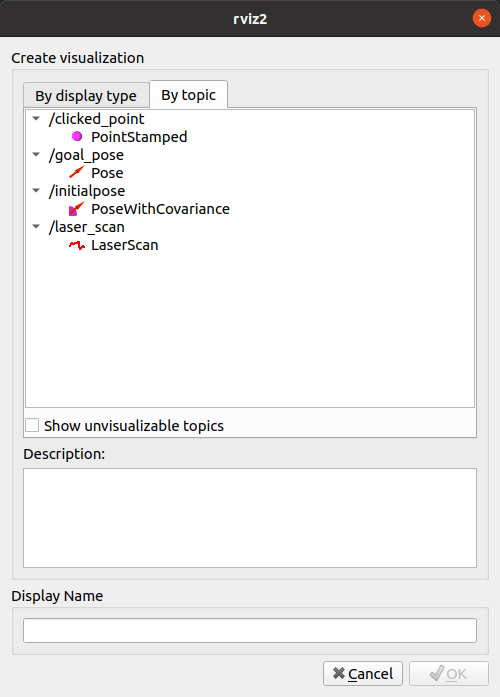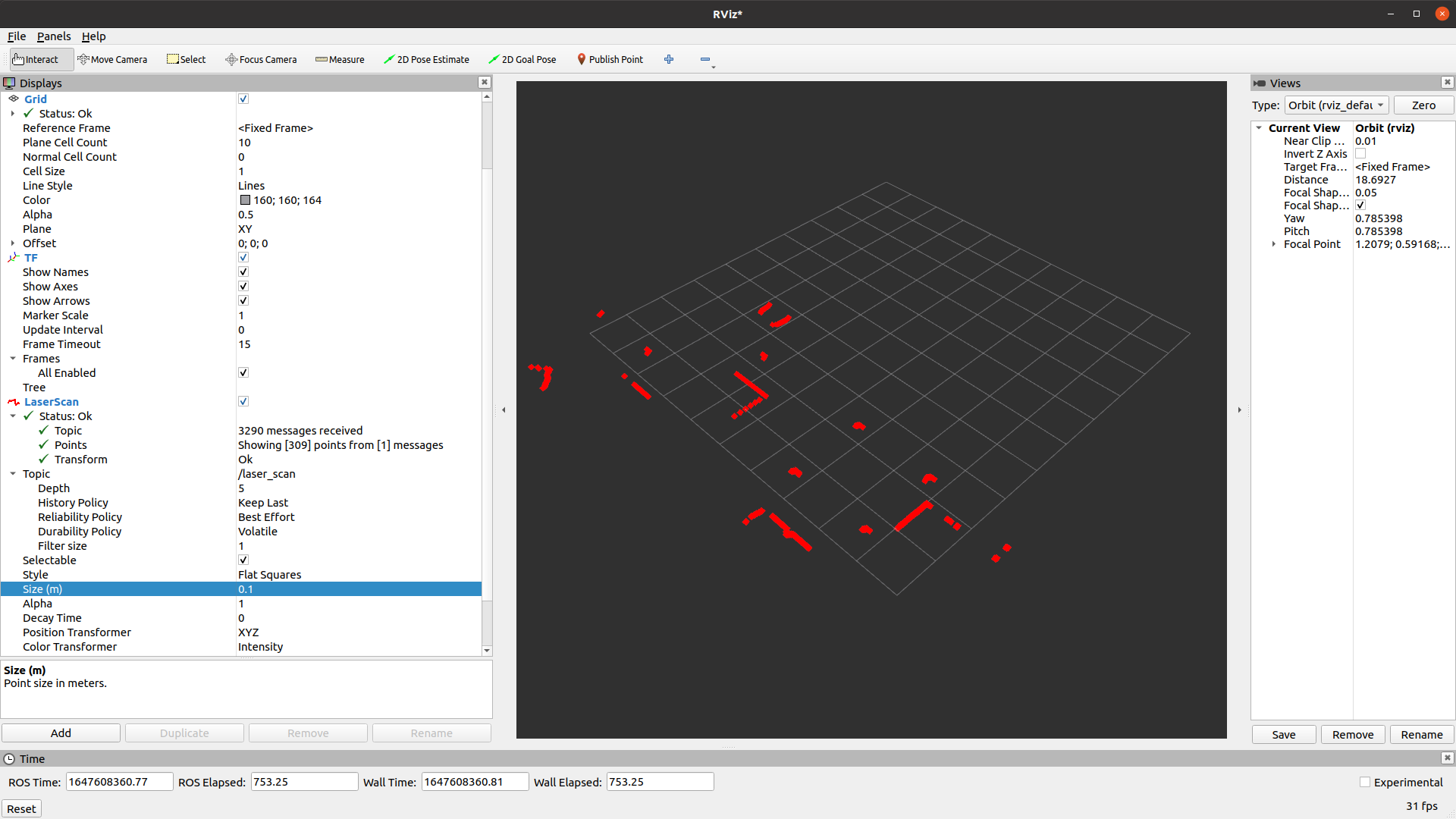ros2+gazebo仿真官方示例
Setting up a robot simulation (Gazebo)?
Goal:?Launch a Simulation with Gazebo and ROS 2
Tutorial level:?Advanced
Time:?20 minutes
Contents
Prerequisites?
First of all you should install ROS 2 and Gazebo. You have two options:
Install from deb packages. To check which versions are available from deb packages please check this?table.
Compile from sources:
Tasks?
1 Launch the simulation?
In this demo you are going to simulate a simple diff drive robot in Gazebo. You are going to use one of the worlds defined in the Gazebo examples called?visualize_lidar.sdf. To run this example you should execute the following command in a terminal:
Linux
ign gazebo -v 4 -r visualize_lidar.sdf
When the simulation is running you can check the topics provided by Gazebo with the?ign?command line tool:
Linux
ign topic -l 这个ing是因为gazebo在Ubuntu里面那个软件就是ign开头的叫做ignxxxx gazebo
Which should show:
/clock /gazebo/resource_paths /gui/camera/pose /gui/record_video/stats /model/vehicle_blue/odometry /model/vehicle_blue/tf /stats /world/visualize_lidar_world/clock /world/visualize_lidar_world/dynamic_pose/info /world/visualize_lidar_world/pose/info /world/visualize_lidar_world/scene/deletion /world/visualize_lidar_world/scene/info /world/visualize_lidar_world/state /world/visualize_lidar_world/stats
Since you have not launched an ROS 2 nodes yet, the output from?ros2?topic?list?should be free of any robot topics:
Linux
ros2 topic list
Which should show:
/parameter_events /rosout
2 Configuring ROS 2?
To be able to communicate our simulation with ROS 2 you need to use a package
called?ros_gz_bridge. This package provides a network bridge which enables the exchange of messages between ROS 2 and Gazebo Transport. You can install this package by typing:
这里需要下载一个ros_gz_bridge功能包,用来接受ros2文件的cmd_vel发出的消息,然后转化为gazebo内机器人识别的命令,因该是个虚拟的驱动包
Linux
sudo apt-get install ros-humble-ros-ign-bridge
At this point you are ready to launch a bridge from ROS to Gazebo. In particular you are going to create a bridge for the topic?/model/vehicle_blue/cmd_vel:
Linux
source /opt/ros/humble/setup.bash ros2 run ros_gz_bridge parameter_bridge /model/vehicle_blue/cmd_vel@geometry_msgs/msg/Twist]ignition.msgs.Twists
上面的2行需要合并一行;? ? ? ??
其中第二行的命令格式:
ros2 run ros_gz_bridge parameter_bridge /TOPIC@ROS_MSG@GZ_MSG?不过好像其中第二个@既可以是@也可以使用 ']'这个括号代替也可以正常执行
具体解释:
The ROS message type is followed by an?@,?[, or?]?symbol where:
@?is a bidirectional bridge.[?is a bridge from Gazebo to ROS.]?is a bridge from ROS to Gazebo.
如果第二个@的位置使用符号@,那么代表这是一个双向传递的通道。测试常用
如果第二个@的位置使用符号[,表示数据从gazebo向ROS2传递
如果第二个@的位置使用符号】,表示数据从ros2向gazebo传递,这里使用了],表示信息(在这里也就是命令)单向从ros2传递到gazebo。
For more details about the?ros_gz_bridge?please check this?README?.
Once the bridge is running the robot is able to follow your motor commands. There are two options:
-
Send a command to the topic using?
ros2?topic?pub
Linux
ros2 topic pub /model/vehicle_blue/cmd_vel geometry_msgs/Twist "linear: { x: 0.1 }"
?这个格式可能是:ros2 topic pub 节点名称 消息类型? ?”具体消息内容“
这个命令可真好用没有安装任何的包也可以伪装成那个包发送消息
-
teleop_twist_keyboard?package. This node takes keypresses from the keyboard and publishes them as Twist messages. You can install it typing:
Linux
sudo apt-get install ros-humble-teleop-twist-keyboardThe default topic where?
teleop_twist_keyboard?is publishing Twist messages is?/cmd_vel?but you can remap this topic to make use of the topic used in the bridge:Linux
source /opt/ros/humble/setup.bash ros2 run teleop_twist_keyboard teleop_twist_keyboard --ros-args -r /cmd_vel:=/model/vehicle_blue/cmd_velWhich will show:
This node takes keypresses from the keyboard and publishes them as Twist messages. It works best with a US keyboard layout. --------------------------- Moving around: u i o j k l m , . For Holonomic mode (strafing), hold down the shift key: --------------------------- U I O J K L M < > t : up (+z) b : down (-z) anything else : stop q/z : increase/decrease max speeds by 10% w/x : increase/decrease only linear speed by 10% e/c : increase/decrease only angular speed by 10% CTRL-C to quit currently: speed 0.5 turn 1.0
3 Visualizing lidar data in ROS 2?
The diff drive robot has a lidar. To send the data generated by Gazebo to ROS 2, you need to launch another bridge. In the case the data from the lidar is provided in the Gazebo Transport topic?/lidar2, which you are going to remap in the bridge. This topic will be available under the topic?/lidar_scan:
Linux
source /opt/ros/humble/setup.bash ros2 run ros_gz_bridge parameter_bridge /lidar2@sensor_msgs/msg/LaserScan[ignition.msgs.LaserScan --ros-args -r /lidar2:=/laser_scan
To visualize the data from the lidar in ROS 2 you can use Rviz2:
Linux
source /opt/ros/humble/setup.bash rviz2
Then you need to configure the?fixed?frame:

And then click in the button “Add” to include a display to visualize the lidar:

Now you should see the data from the lidar in Rviz2:

Summary?
In this tutorial, you launched a robot simulation with Gazebo, launched bridges with actuators and sensors, visualized data from a sensor, and moved a diff drive robot.
本文来自互联网用户投稿,该文观点仅代表作者本人,不代表本站立场。本站仅提供信息存储空间服务,不拥有所有权,不承担相关法律责任。 如若内容造成侵权/违法违规/事实不符,请联系我的编程经验分享网邮箱:veading@qq.com进行投诉反馈,一经查实,立即删除!